Introduction
Pressure ulcer (also referred to as pressure/bed sore, and decubitus ulcer) is an area of locally damaged tissue formed by unrelieved pressure. It is usually located over a bony prominence. Pressure ulcer brings about ischemia, necrosis, and cell death (McInnes et al., 2015).
Risk groups include (McInnes et al., 2015):
- patients suffering from serious diseases;
- patients having spinal cord injuries;
- patients whose mobility is impaired;
- patients who wear prostheses or a plaster cast;
- completely paralyzed patients;
- patients with obesity;
- patients who have nutrition problems;
- elderly patients;
- pregnant women.
Pressure ulcers can be caused by inappropriate posture (which aggravates pressure on bones) or some unsuitable equipment.
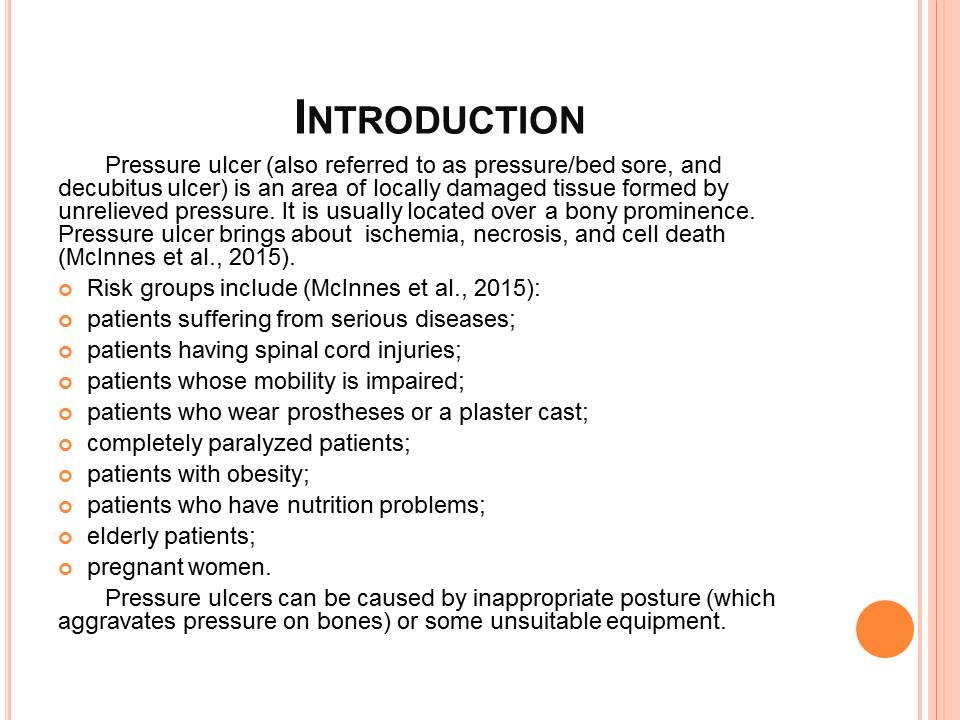
The Problem of Pressure Ulcers
There exist a lot of problems connected with pressure ulcers treatment and prevention (Berlowitz et al., 2011):
- About 2.5 million hospital patients in the United States suffer from pressure ulcers of different stages.
- The condition is not only painful but also fraught with serious infections that can bring about more dangerous diseases.
- The Centers for Medicare & Medicaid refused to give more financial support to hospitals for treating pressure ulcers.
- Those treatment methods that have proved to be successful are not applied systematically and are not developed.
- A lot of hospitals do not approach the problem as it requires a lot of modernization, expenses, and labor force.
Owing to all the existing challenges, pressure ulcer prevention is a complex problem that requires a comprehensive approach in order to find an effective solution. Some aspects of this process are universal and concern routine nursing, whereas others may be specific for each particular patient and his/her reaction to treatment. Thus, a detailed care plan must be developed for each case of pressure ulcers. This task is manageable only if multiple teams of health care providers are involved (Berlowitz et al., 2011).

Classification of Pressure Ulcers
There are several stages of pressure ulcers (Cooper, 2013):
- Stage I: the appearance of non-blanchable area of red skin over a prominence;
- Stage II: the appearance of a shallow wound caused by partial-thickness loss of skin, which is restricted to epidermis;
- Stage III: the appearance of a full-thickness wound caused by loss of epidermis and partial destruction of the dermis;
- Stage IV: the loss of epidermis, dermis, and the subsequent muscle layers exposure and destruction.
Unstageable: the loss of tissue with the ulcer bed covered by slough or eschar, which accounts for the fact that the depth of the wound cannot be estimated correctly;
Deep tissue injury: the appearance of a blue or purple area over the area subjected to pressure;
Kennedy terminal ulcer: the appearance of a deep wound.
At the first stage it is highly important to estimate the state of the red area at the second turning of the patient accompanied by the close inspection of his/her skin. It is necessary for identifying if the redness disappeared. The point is that reactive hyperemia is normal when there is constant pressure on the tissue. When it is relieved, the skin should go back to its normal color. If the area stays non-blanchable, it means that we deal with a pressure ulcer. Stage II ulcer resembles a fluid-filled blister. Stage III pressure ulcer, being relatively serious, still does not presuppose muscle damage. Neither does it involve tendon or bone tissue. Stage IV implies that bones and tendon can be affected. Unstageable pressure ulcer is characterized by a serious wound covered by a hard, thick, dark tissue. Deep tissue injury follows this stage. It usually looks like a blood-filled blister. Kennedy terminal ulcer progresses rapidly and is very difficult to treat as it can deeply destroy epidermis, muscles, and bones (Cooper, 2013).
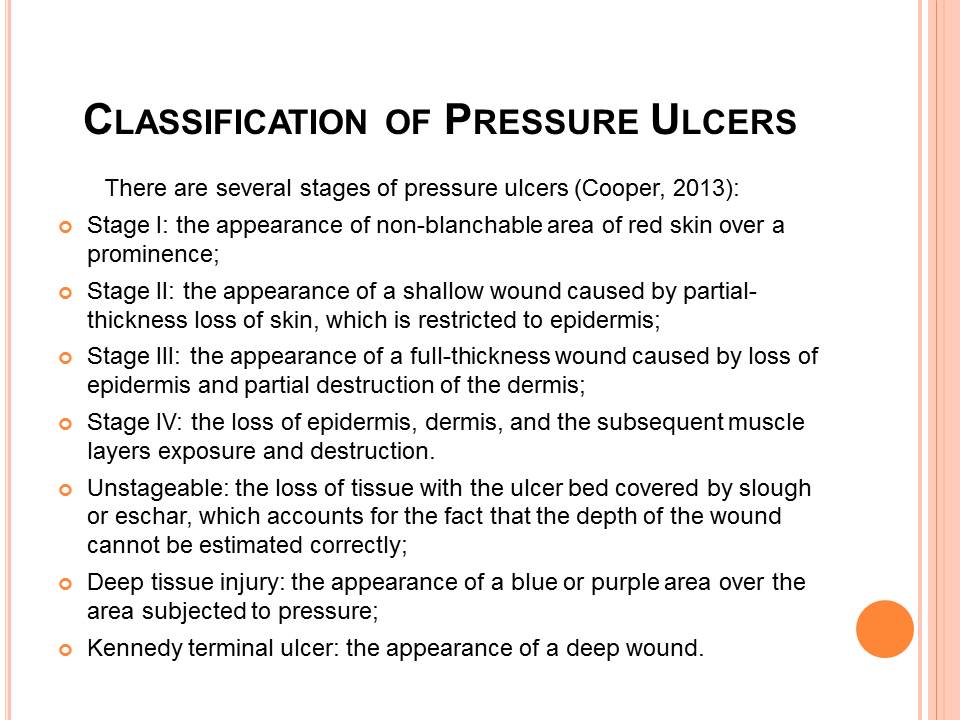
Factors Leading to Pressure Ulcers
Extrinsic factors that can lead to the appearance of pressure ulcers include (Qaseem, Mir, Starkey, & Denberg, 2015):
- pressure (causing compression and tissue ischaemia);
- shearing (leading to necrosis), which occurs when the skeleton slides down because of gravity;
- friction (resulting from poor handling techniques), which is caused by two surfaces moving against each other;
- moisture (urine, faeces, would exudates, etc.), which can be prevented if the skin is kept dry and well-hydrated.
Intrinsic factors are more difficult to handle. Among the most serious ones are the following (Qaseem, Mir, Starkey, & Denberg, 2015):
- acute or chronic diseases (e.g. cardiovascular disease, vasomotor failure, diabetes, etc.);
- low awareness of the necessity to move in order to avoid pressure ulcers;
- immobility;
- reaction to medications;
- sensory impairment (which causes lack of stimulus to deal with pressure);
- age problems;
- poor nutrition;
- dehydration (reducing skin elasticity).
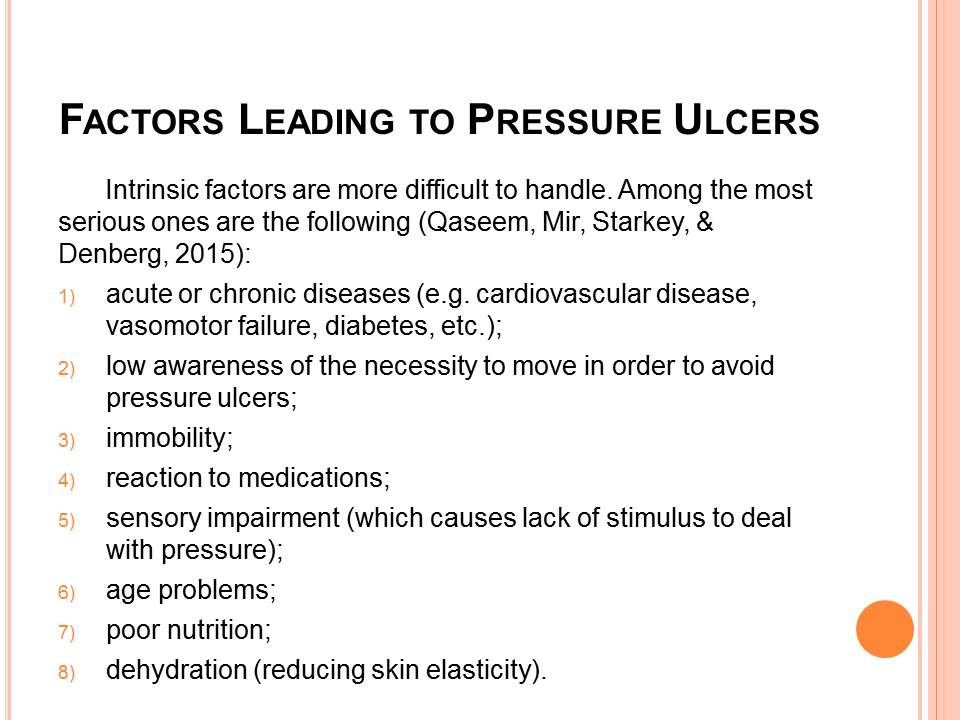
The Proposed Changes
There should be introduced a number of changes in order to prevent pressure ulcers (Nursing Care Center Accreditation Program, 2016):
- all the important information concerning the patient’s condition that can lead to the development of pressure ulcers (immobility, poor nutrition, dehydration, etc.) should be collected within the first 8 hours of his/her hospitalization;
- patients must be made aware of the risks of developing pressure ulcers in due time;
- risk assessment must identify factors that may trigger the appearance of pressure ulcers or aggravate the condition;
- extrinsic factors causing tissue destruction must be approached before they harm the patient;
- intrinsic factors must be regarded not separately but comprehensively;
- change management plan should rely upon the most common cases but also presuppose variations for each individual case;
- nurses should create a supportive and protective physical, psychological, and cultural environment for their patients.
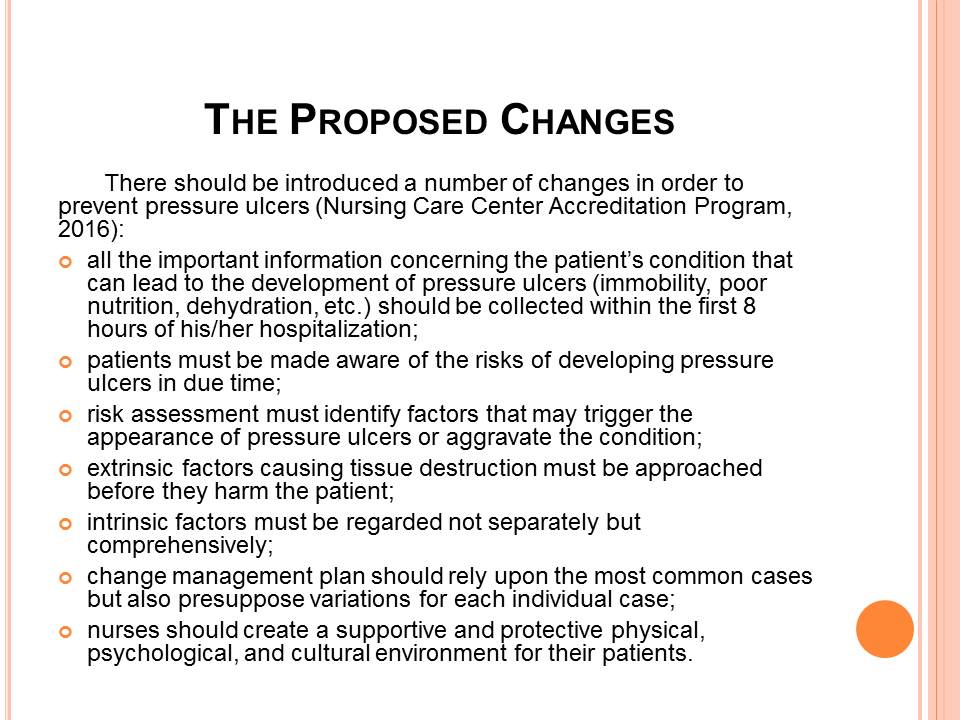
Theories Supporting The Changes
The enumerated changes are supported by the following theories:
- the Theory of Holistic Nursing (Papathanasiou, Sklavou, & Kourkouta, 2013);
- DSM-5 Model (Skodol, Morey, Bender, & Oldham, 2015).
- Watson’s Theory of Human Caring (Watson, 2012).
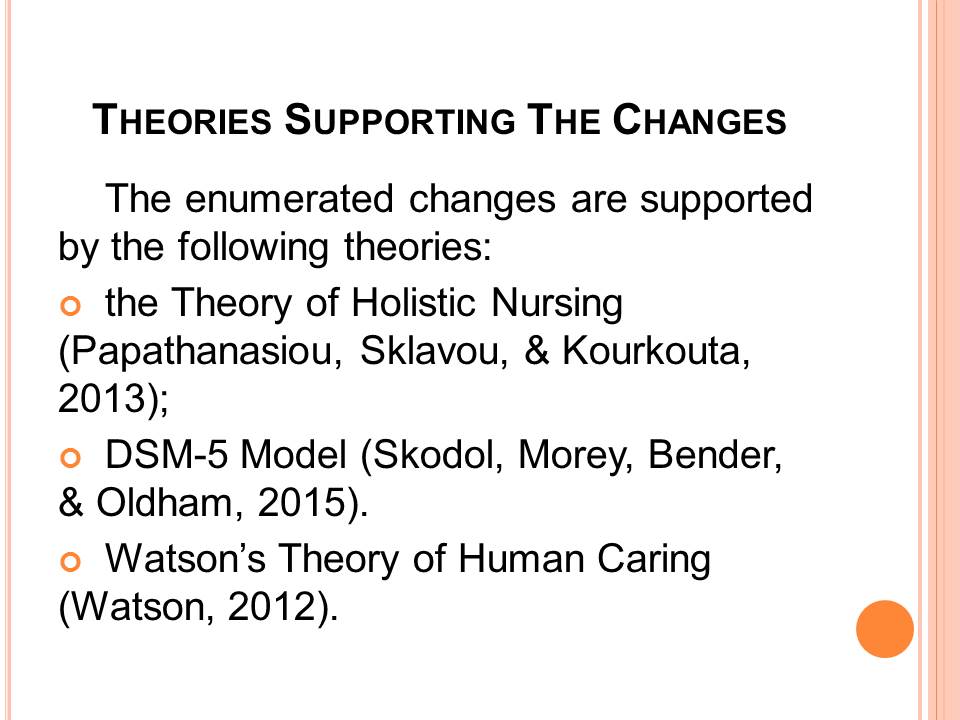
Change Strategies
- A team of qualified specialists (including staff nurses, nurse manager, nutritionist, pharmacists, physicians, and senior leader) must be created for the implementation of change management plan;
- The most modern equipment and protective devices must be provided in order to ensure comfortable positioning and protection from the external risks;
- Educational programs should be launched for the staff in order to teach them how to use the technologies for prevention purposes.
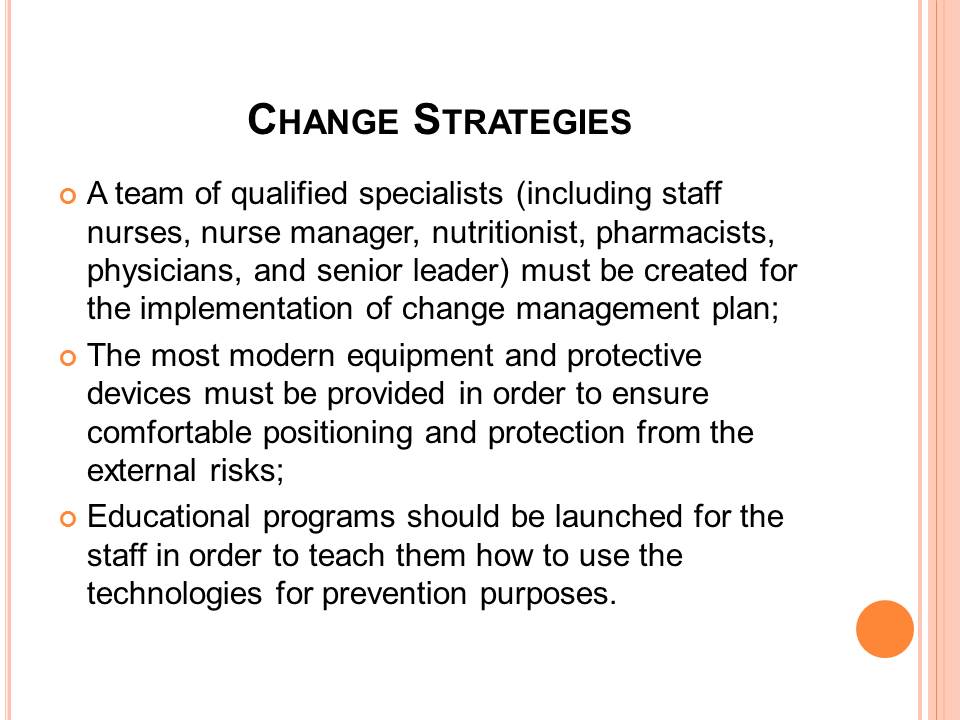
The Pros and Cons of the Strategies
Pros:
- a wide range of specialists can address all needs of a patient;
- modern equipment reduces the chances of pressure ulcer occurrence;
- educational programs ensure that the staff’s actions will not aggravate the condition;
Cons:
- too many people involved in treatment may propose contradicting strategies and methods;
- the equipment is costly and hard to obtain for some hospitals;
- education takes time and effort, which requires high commitment from the staff and may reduce job satisfaction rates.
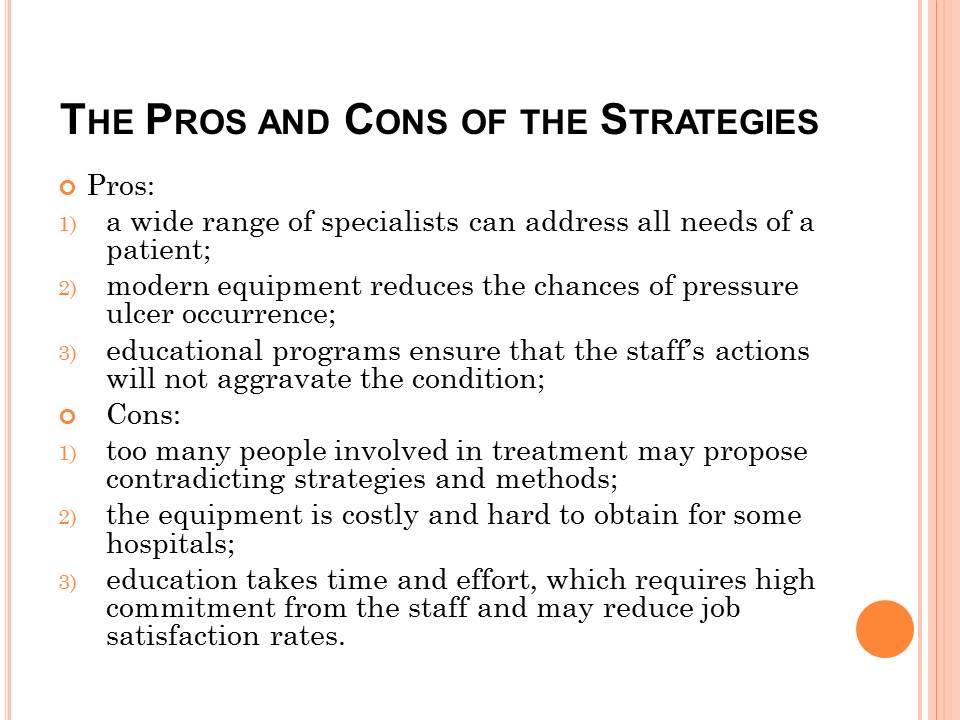
Lean Principles
- Elimination of non-value-added activity (which means avoiding any kind of redundant actions that do not lead to pressure ulcer prevention);
- Making use of modern technologies in order to reduce manual labor and improve effectiveness of the treatment;
- Develop skills of those people who directly interact with patients;
- Focus on systematic improvement (which implies identification of root causes in order to prevent problems in future) (Burgess & Radnor, 2013).
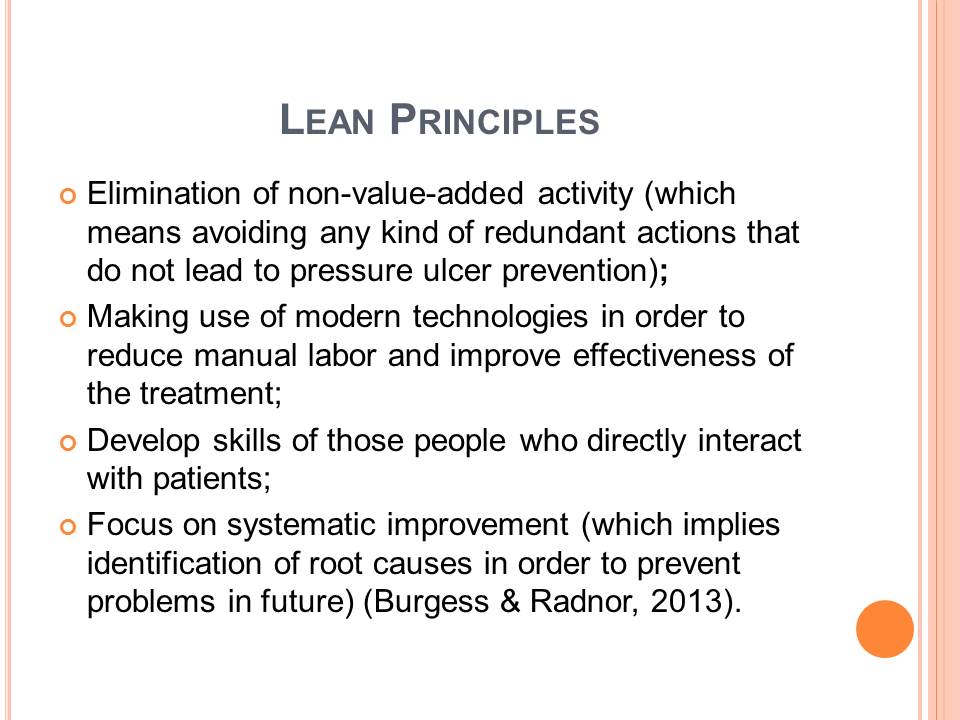
The Role of Teams
- risk assessment should be performed in time (the Braden scale is recommended);
- a skin inspection should be done by a team member on patients within several hours admission; re-inspection must occur every 8 hours;
- team members must minimize or eliminate all aggravating factors (friction, shear, etc.) and provide proper nutrition and hydration;
- team members must address psychological needs of their patients;
- the results of all assessments must be documented;
- team members should inform patients and their family about the key issues of prevention.
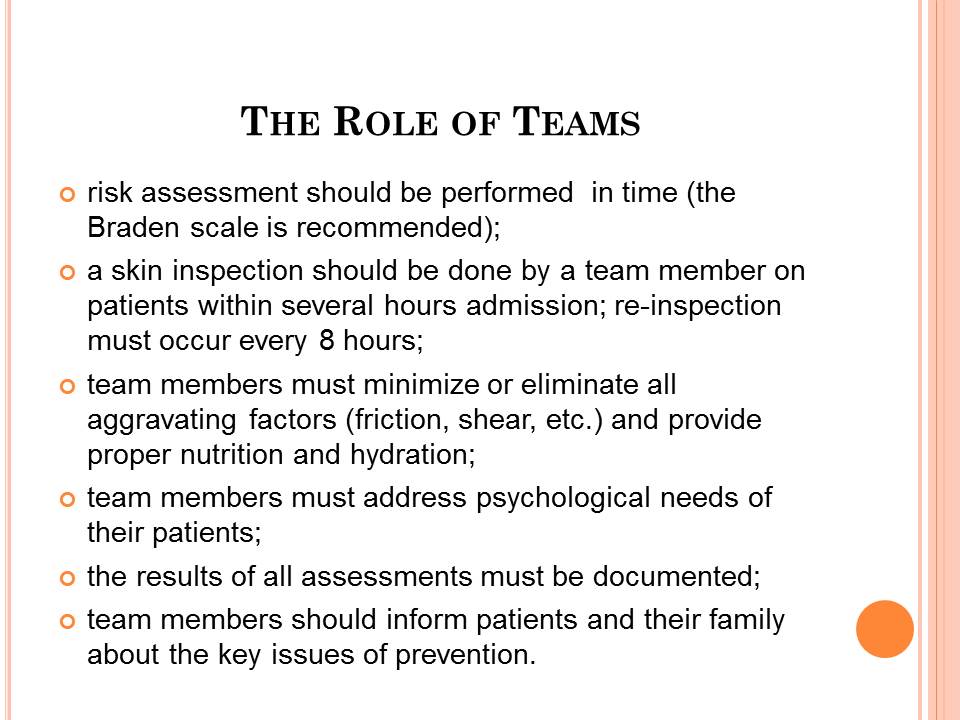
Conclusion
Pressure ulcers is an issue of paramount importance as it is associated with the risk of death if the problem is not addressed in due time. There are certain risk factors, which include age, immobility, serious diseases, etc. that can cause pressure ulcers and should be eliminated at the initial stage. The use of educational strategies for both the staff and patients coupled with the implementation of modern technologies can be very effective in prevention of all possible complications. However, the strategies should be adapted to the clinical settings of each particular hospital.
Pressure ulcers are preventable if risk factors are assessed and patients are informed and monitored properly. In case prevention fails, most pressure ulcers heal with careful treatment.
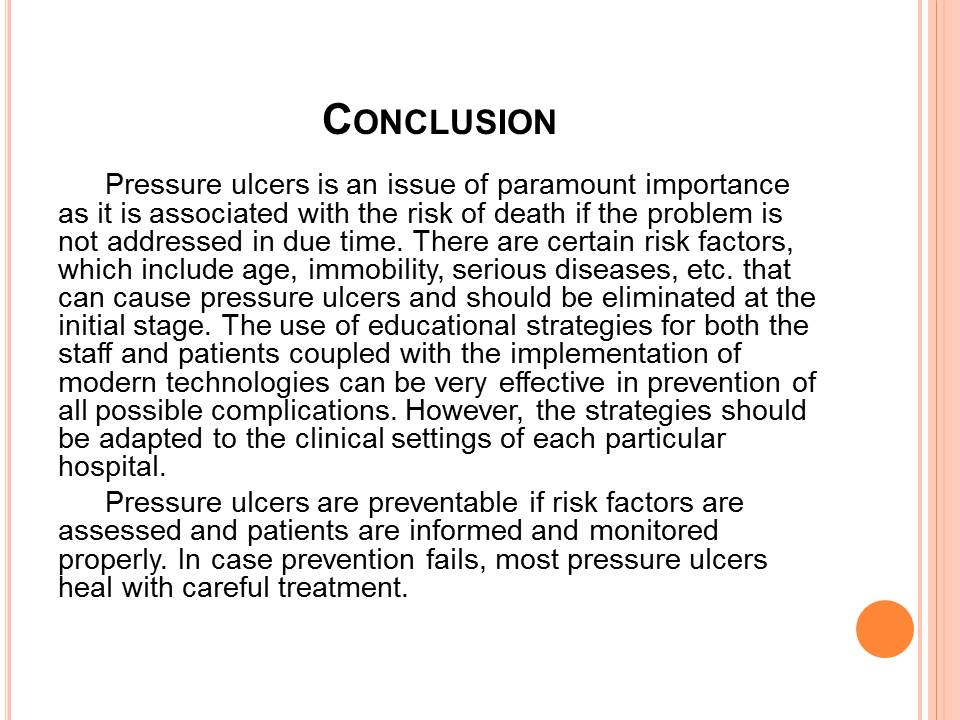
References
Berlowitz, D., Lukas, C. V., Parker, V., Niederhauser, A., Silver, J., & Logan, C. (2012). Preventing pressure ulcers in hospitals: a toolkit for improving quality of care. Rockville, MD: Agency for Healthcare Research and Quality.
Burgess, N., & Radnor, Z. (2013). Evaluating Lean in healthcare. InternationalJournalof HealthCareQualityAssurance, 26(3), 220-235.
Cooper, K. L. (2013). Evidence-based prevention of pressure ulcers in the intensive care unit. CriticalCareNurse, 33(6), 57-66.
McInnes, E., Jammali‐Blasi, A., Bell‐Syer, S. E., Dumville, J. C., Middleton, V., & Cullum, N. (2015). Support surfaces for pressure ulcer prevention. The Cochrane Library, 1-142.
Nursing Care Center Accreditation Program. (2016). National Patient Safety Goals Effective. Web.
Papathanasiou, I., Sklavou, M., & Kourkouta, L. (2013). Holistic nursing care: theories and perspectives. American Journal of Nursing Science, 2(1), 1-5.
Qaseem, A., Mir, T. P., Starkey, M., & Denberg, T. D. (2015). Risk assessment and prevention of pressure ulcers: a clinical practice guideline from the American College of Physicians. Annalsofinternalmedicine, 162(5), 359-369.
Skodol, A. E., Morey, L. C., Bender, D. S., & Oldham, J. M. (2015). The alternative DSM-5 model for personality disorders: a clinical application. AmericanJournalofPsychiatry, 172(7), 606-613.
Watson, J. (2012). The theory of human caring: Retrospective and prospective. Caring in Nursing Classics: An Essential Resource, 237-270.